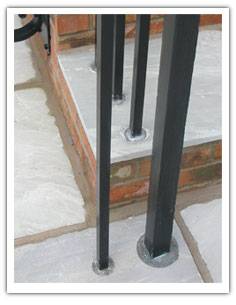Finding gates for a period property is not easy. Original antique gates are ideal but rare. Even if you find one, often the size is wrong or the gate may need so much restoration that it is not viable. Narrow widths of 9ft or 10ft are common, along with low overthrows, making antique gates impractical for modern traffic needs. Many of our customers have spent years of searching before finding us.
How can we help?
We can design a gate to fit any space, shape and style. Many of our designs are inspired by original 18th and 19th century gates but we can also replicate an original gate from a photograph or drawing. We can incorporate new elements such as a family crest or create an entirely different design for you. Our gates are made in Vietnam where both the nature of the steel used and the manufacturing process, with much hand working, makes them highly suitable for period work.
Hidden welding
We can construct our gates in a way that makes them look very similar to antique gates. With prominent rivet work and straps that hold the sections together, we can dress welds carefully to make the joins less visible to the eye.
The handmade element
Our gates show that the steel has been vigorously worked. Our craftsmen spend a lot of time cutting, grinding, hammering, welding and forging the steel. This means that every line or curve has a handmade look, with the slight irregularities characteristic of such ironwork.
Hot rolled steel
We use hot rolled steel which is not extruded through a die but forced between rollers when red hot. This imparts certain characteristics to the material - it is irregular along its length and slight folds can be seen here and there. It’s the ideal choice for period ironwork.
Blacksmith’s forge
Our blacksmith’s forge, which uses coal fired with air forced through from beneath, heats iron to temperatures up to 800°C. When red hot, the steel is wrought into shape using hammers.
Preserving the past
Many of the designs we recreate haven’t been seen for centuries. Sometimes the original gates are lost forever; old publications and blurred photographs are all that remain.
Adding a modern touch
Many customers want automated gates. We fit and test automation motors to our gates in the factory to ensure they are correctly engineered. A video can be emailed to you showing the gates in automation before you take delivery. This ensures that the installation process is as simple as possible.
We favour the CAME automation system (www.cameuk.com). For further information and product specifications please visit: gateinstaller.co.uk/automation/motors.html
Working with lead
The traditional method of securing ironwork is by pouring molten lead into recesses into which ironwork sections are fitted (see image, right). This is a very secure and permanent fixing preferred by listed property owners and conservation specialists. We can provide this service; these images show the brackets of our Hurley Hall gates set into the top of retaining walls.
Core drilling
Steel sections can be recessed into stone and secured with construction grout or lead. This gives a very rigid and attractive finish to period ironwork.

Peter Weldon Iron Designs Ltd is compliant with the ‘Contractors Health and Safety Assessment Scheme’. PWID Ltd is registered on the Chas scheme database.
|












